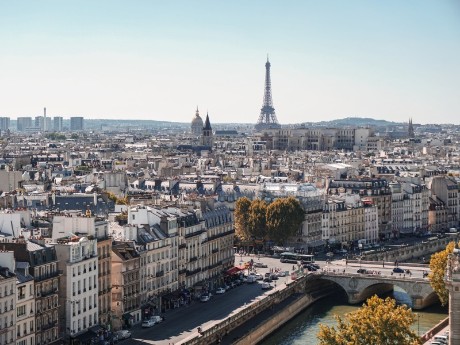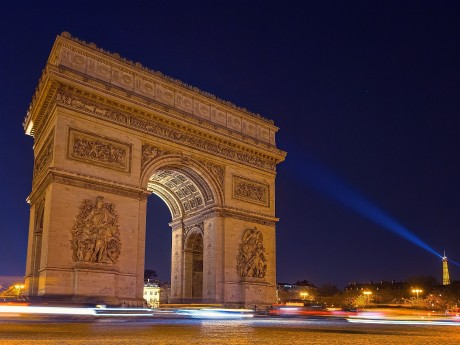France: Paris
France weaves a captivating mosaic of enchanting urban romance and unparalleled elegance. This trip highlights the artistic opulence and gastronomic finesse of Paris, showcasing renowned monuments such as the Palace of Versailles, Jardin du Luxembourg, Arc de Triomphe and more. Explore beauty and charm at a top-of-the-world view from the Eiffel Tower, encounters with the Mona Lisa at the Louvre, and fashionable delights on Champs de Élysées. A romantic Seine river dinner cruise is a must.
Read more
France weaves a captivating mosaic of enchanting urban romance and unparalleled elegance. This trip highlights the artistic opulence and gastronomic finesse of Paris, showcasing renowned monuments such as the Palace of Versailles, Jardin du Luxembourg, Arc de Triomphe and more. Explore beauty and charm at a top-of-the-world view from the Eiffel Tower, encounters with the Mona Lisa at the Louvre, and fashionable delights on Champs de Élysées. A romantic Seine river dinner cruise is a must. From visiting Disneyland Paris, to having a wine and cheese tasting, there is always something for everyone! Waterviews strives to offer accommodation options within walking distance of water and/or in an area of touristic interest. Our prices include taxes (but excludes local tourist taxes). Customize your trip to your personal preferences with optional activities (hit the “Add Activities’’) or change hotels, etc. Contact us for customization at no extra cost at: Service@waterviewstravel.com
Destinations
- Paris
Itinerary
Paris

Renowned all over the world as a hub for art, fashion and culture, Paris is an enchanting city that is sure to make you fall in love. Its romantic atmosphere and beautiful setting on the banks of the River Seine are instantly charming, and the rich history, countless iconic landmarks and incredible culinary scene are like no other. Stroll through elegant boulevards, marvel at the Eiffel Tower, spend afternoons meandering in the Louvre and discover charming neighbourhoods - you won't be disappointed with the City of Light.
Read more
Renowned all over the world as a hub for art, fashion and culture, Paris is an enchanting city that is sure to make you fall in love. Its romantic atmosphere and beautiful setting on the banks of the River Seine are instantly charming, and the rich history, countless iconic landmarks and incredible culinary scene are like no other. Stroll through elegant boulevards, marvel at the Eiffel Tower, spend afternoons meandering in the Louvre and discover charming neighbourhoods - you won't be disappointed with the City of Light.
Additional Information
Due to high expectations, a tight schedule, and large crowds and long lines at certain attractions during high season, the city might disappoint some visitors. Foreign visitors who have an idealized view of Paris might be shocked by the typical challenges of visiting any large city; crime, traffic noise, pollution, garbage, and relatively high costs. In the worst case, visitors might experience the Paris syndrome; a psychological state of delusion.
To enjoy the wonders of Paris, make realistic plans. The amounts of attractions and landmarks is overwhelming; visiting only the most famous ones takes more than a week. The city also has more to offer for people who take time for a calm stroll along the backstreets. If your time in the city is short, be selective, and save some attractions for your next visit.
History
Paris started life as the Celto-Roman settlement of Lutetia on the Île de la Cité, the island in the Seine now occupied by the Cathédrale de Notre Dame. It takes its present name from the name of the dominant Gallo-Celtic tribe in the region, the Parisii. At least that's what the Romans called them, when they showed up in 52 BCE and established their city Lutetia on the left bank of the Seine, in what is now called the "Latin Quarter" in the 5th arrondissement.
The Romans held out here for as long as anywhere else in the Western Empire, but by 508 CE they were gone, replaced by Clovis of the Franks, who is considered by the French to have been their first king. Clovis' descendants, aka the Carolingians, held onto the expanded Lutetian state for nearly 500 years through Viking raids and other calamities, which finally resulted in a forced move by most of the population back to the islands which had been the centre of the original Celtic village. The Capetian Duke of Paris was voted to succeed the last of the Carolingians as King of France, ensuring the city a premier position in the medieval world. Over the next several centuries Paris expanded onto the right bank into what was and is still called le Marais (The Marsh). Quite a few buildings from this time can be seen in the 4th arrondissement.
The medieval period also witnessed the founding of the Sorbonne. As the "University of Paris", it became one of the most important centres for learning in Europe—if not the whole world, for several hundred years. Most of the institutions that still constitute the University are found in the 5th, and 13th arrondissements.
In the late 18th century, there was a period of political and social upheaval in France and Europe, during which the French governmental structure, previously a monarchy with feudal privileges for the aristocracy and Catholic clergy, underwent radical change to forms based on Enlightenment principles of nationalism, citizenship, and inalienable rights. Notable events during and following the revolution were the storming of the Bastille 4th arrondissements, and the rise and fall of Napoleonic France. Out of the violent turmoil that was the French Revolution, sparked by the still known Passion des Français, emerged the enlightened modern day France.
The Paris of today was built long after the Capetian and later the Bourbon Kings of France made their mark on Paris with the Louvre and the Palais Royal, both in the 1st. In the 19th century, Baron von Hausmann set about reconstructing the city, by adding the long straight avenues and replacing many of the then existing medieval houses, with grander and more uniform buildings.
New wonders arrived during La Belle Époque, as the Parisian golden age of the late 19th century is known. Gustave Eiffel's famous tower, the first metro lines, most of the parks, and the streetlights (which are partly believed to have given the city its epithet "the city of light") all come from this period. Another source of the epithet comes from Ville Lumière, a reference not only to the revolutionary electrical lighting system implemented in the streets of Paris, but also to the prominence and aura of Enlightenment the city gained in that era.
The twentieth century was hard on Paris, but thankfully not as hard as it could have been. Both world wars took a heavy toll on the city's inhabitants, but at least Hitler's order to burn the city was ignored by the German General von Choltitz, who was quite possibly convinced by a Swedish diplomat that it would be better to surrender and be remembered as the saviour of Paris, rather than its destroyer. Following the war, the city recovered quickly at first, but slowed in the 1970s and 1980s when Paris began to experience some of the problems faced by big cities everywhere: pollution, housing shortages, and occasionally failed experiments in urban renewal.
However, post-war Paris enjoyed considerable growth as a multi-cultural city, with new immigrants from all corners of the world, especially La Francophonie, including most of northern and western Africa as well as Indochina. These immigrants brought their foods and music, both of which are of prime interest for many travellers.
Immigration and multi-culturalism continues in the 21st century with a marked increase in the arrival of people from Latin America, especially Mexico, Colombia, and Brazil. In the late 1990s, it was hard to find good Mexican food in Paris, whereas today there are dozens of possibilities from lowly taquerias in the outer arrondissements to nice sit-down restaurants on the boulevards. Meanwhile Latin music from salsa to samba is all the rage (well, alongside Paris lounge electronica).
The 21st century has also seen vast improvements in the general liveability of Paris, with the mayor's office concentrating on reducing pollution and improving facilities for soft forms of transportation including a huge network of cycle paths, larger pedestrian districts and newer faster metro lines. Visitors who normally arrive car-less are the beneficiaries of these policies as much as the Parisians themselves are.
Climate
Paris has a maritime climate with cool winters and warm summers. The moderating effect of the Atlantic Ocean helps to temper temperature extremes in much of western Europe, including France. Even in January, the coldest month, temperatures nearly always exceed the freezing point with an average high of 7°C. Snow is not common in Paris, although it will fall a few times a year. Most of Paris' precipitation comes in the form of light rain year-round.
Summers in Paris are warm and humid, with an average high of 25°C during the mid-summer months. Occasional heat waves can push temperatures above 35°C.
Spring and fall are normally cool and wet.
© Sourced from Wikivoyage





